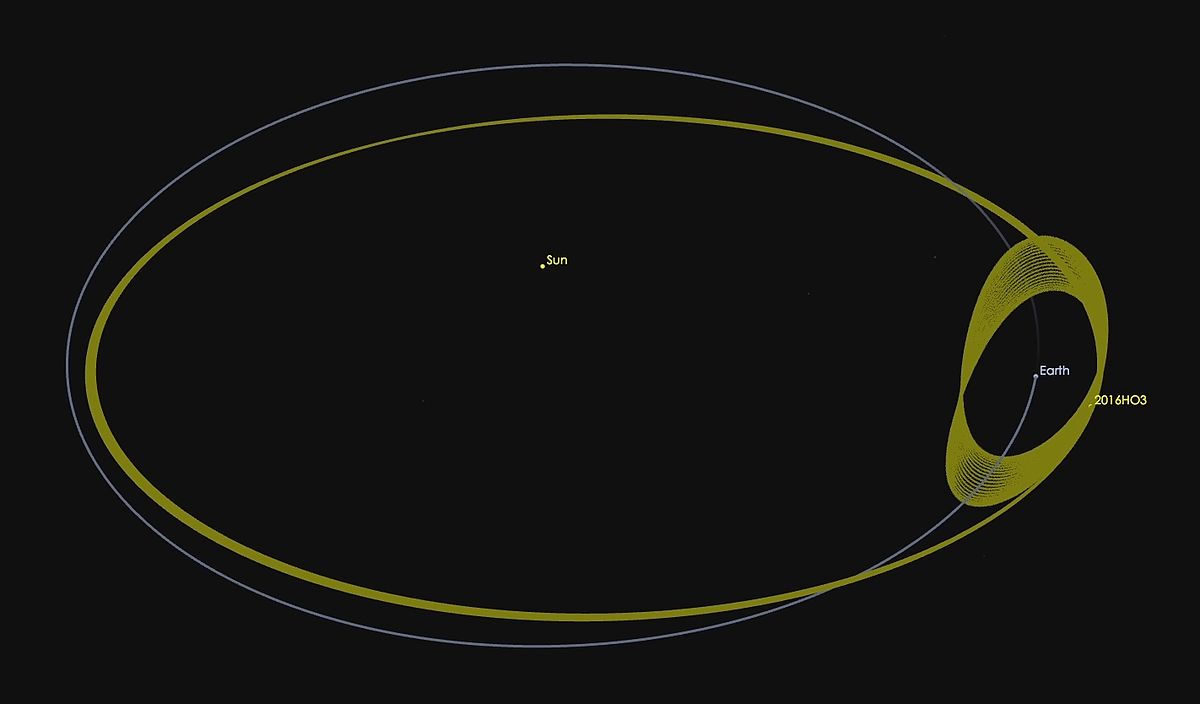Asteroid 2016 HO3 was first spotted on April 27, 2016, by the Pan-STARRS 1 asteroid survey telescope on Haleakala, Hawaii, operated by the University of Hawaii's Institute for Astronomy.
Asteroid 2016 HO3 was first spotted on April 27, 2016, by the Pan-STARRS 1 asteroid survey telescope on Haleakala, Hawaii, operated by the University of Hawaii's Institute for Astronomy and funded by NASA's Planetary Defense Coordination Office. Asteroid 2016 HO3 was first spotted on April 27 2016 by the Pan-STARRS 1, a telescope on Haleakala, Hawaii. The Pan-STARRS 1 (Panoramic Survey Telescope & Rapid Response System) observe the entire sky to discover and characterize Earth’ near objects, both asteroids &.
NASA’ scientists have detected a tiny asteroid, smaller than the Statue of Liberty, that is constantly encircling the Earth while the two objects orbit the sun together.
The new satellite, dubbed 2016 HO3, will remain Earth’s companion for the next few hundred years, spinning in its own chaotic dance around the Earth.
Technically speaking, 2016 HO3 is not a moon of Earth, as it orbits the sun, it loops around Earth as well, but it’s too far to be considered a true natural satellite of our planet, thus astronomers calling it a quasi-satellite. Download window media player for mac free.
Earth has one permanently satellite, the Moon, and several temporary quasi-satellite companions: these are 2004 GU9, 2006 FV35, 2013 LX28, 2014 OL339 and the newly one 2016 HO3.
Since 2016 HO3 loops around our planet, but never ventures very far away as we both go around the Sun, we refer to it as a quasi-satellite of Earth,
said Paul Chodas.
One other asteroid — 2003 YN107 — followed a similar orbital pattern for a while over 10 years ago, but it has since departed our vicinity. Time machine mac download free. This new asteroid is much more locked onto us. Our calculations indicate 2016 HO3 has been a stable quasi-satellite of Earth for almost a century, and it will continue to follow this pattern as Earth’s companion for centuries to come.
2016 HO3 path as it orbits the sun ©NASA/JPL-Caltech.


2016 Ho3 Moon
Asteroid 2016 HO3
Asteroid 2016 HO3 was first spotted on April 27 2016 by the Pan-STARRS 1, a telescope on Haleakala, Hawaii.
The Pan-STARRS 1 (Panoramic Survey Telescope & Rapid Response System) observe the entire sky to discover and characterize Earth’ near objects, both asteroids & comets, that could posses a danger to our planet.
Astronomers estimated 2016 HO3 size somewhere between 120 to 300 feet (40-100 meters) across. It path is not dangerous, it will never going to hit us, astronomers explained, as it never gets closer than 14 million kilometers (9 million miles) from Earth — that’s more than about 38 times the Earth-moon distance.
2016 HO3 chaotic dance
In its journey around the sun, asteroid 2016 HO3 spends almost half of the time closer to the sun than the Earth, passing ahead of our planet. It’s orbit is tilted a little, tends to twist and drift over time:
The asteroid’s loops around Earth drift a little ahead or behind from year to year, but when they drift too far forward or backward, Earth’s gravity is just strong enough to reverse the drift and hold onto the asteroid so that it never wanders farther away than about 100 times the distance of the moon,
explained Chodas.
The same effect also prevents the asteroid from approaching much closer than about 38 times the distance of the moon. In effect, this small asteroid is caught in a little dance with Earth.
Asteroid 2016 HO3 is not the first companion picked up by Earth the past. As the scientists explain, the gravity of the planet can capture little space rocks in its orbit that will circle the planet for some time. 2003 YN107 showed a similar orbit over a decade ago, but is no longer orbiting close to Earth.
2016 Ho3 Asteroid
2016 HO3’s uncommon positioning could make it an attainable target for future study as interest in asteroid investigation grows – although the possibility of such a move is slim as of now.
Chodas told the Monitor.
Tags
MoonPlanetoida 2016 Ho3
There are no clear photos of it so, I have no reason to believe it’s not an Earth monitoring satellite placed in orbit by aliens that will alert them when we become too dangerous.
Leave a Comment
Comments FeedQuasimoon
(Need help with these tags?)2016 Ho3 Asteroid
